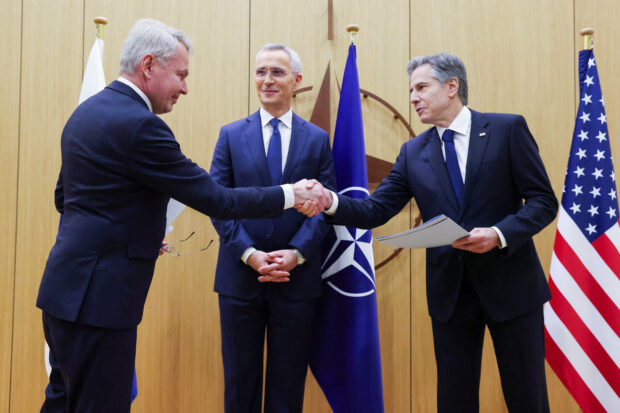
Finnish Foreign Minister Pekka Haavisto shakes hands with U.S. Secretary of State Antony Blinken as NATO Secretary-General Jens Stoltenberg stands during a joining ceremony at the NATO foreign ministers’ meeting at the Alliance’s headquarters in Brussels, Belgium April 4, 2023. REUTERS/Johanna Geron/Pool
HELSINKI/BRUSSELS — Finland formally joined NATO on Tuesday, its flag unfurling outside the military bloc’s Brussels headquarters, in a historic policy shift brought on by Russia’s invasion of Ukraine that drew a threat from Moscow of “counter-measures.”
Finland’s accession, ending seven decades of military non-alignment, roughly doubles the length of the border the North Atlantic Treaty Organization shares with Russia and bolsters its eastern flank as the war in Ukraine grinds on with no resolution in sight.
Finland’s flag – a blue cross on a white background – was hoisted alongside those of the alliance’s 30 other members as a military band played in bright spring sunshine.
“For almost 75 years, this great alliance has shielded our nations and continues to do so today,” NATO Secretary-General Jens Stoltenberg declared at the ceremony. “But war has returned to Europe and Finland has decided to join NATO and be part of the world’s most successful alliance.”
Stoltenberg earlier noted that Russian President Vladimir Putin had cited opposition to NATO’s eastward enlargement as one justification for invading Ukraine.
“He is getting exactly the opposite… Finland today, and soon also Sweden will become a full-fledged member of the alliance,” Stoltenberg said.
Finnish President Saul Niinisto said Finland’s most significant contribution to NATO’s common deterrence and defence would be to defend its own territory. There is still significant work to be done to coordinate this with NATO, he said.
“It is a great day for Finland and I want to say that it is an important day for NATO,” Niinisto said at a joint news conference with Stoltenberg.
The Kremlin said Russia would be forced to take “counter-measures.” Defense Minister Sergei Shoigu said Finland’s accession raised the risk of the Ukraine conflict escalating further.
In dropping non-alignment, Russia’s Foreign Ministry said, Finland was committing a dangerous historical mistake that would fray relations with Moscow and undo its status as a confidence-building presence in the Baltic Sea and Europe at large.
“This is now a thing of the past. Finland has become one of the small members of (NATO) that doesn’t decide anything, losing its special voice in international affairs. We are sure that history will judge this hasty step,” a ministry statement said.
Russia said on Monday it would strengthen its military capacity in its west and northwest in response to Finland joining NATO.
Ukraine hailed Finland’s step.
“I congratulate all the people of Finland,” President Volodymyr Zelenskiy said in his evening address. “Russian aggression clearly proves that only collective guarantees, only preventive guarantees, can be reliable.”
End to military non-alignment
Finland’s era of strategic non-alignment began after the country repelled an attempted Soviet invasion during World War Two and opted to maintain friendly relations with neighboring Russia.
But the invasion of Ukraine in February 2022 prompted Finns to seek security under NATO’s collective defense pact, which states that an attack on one member is an attack on all.
Since the end of the Cold War three decades ago, Moscow has watched successive waves of NATO enlargement, and the issue was contentious even before the invasion of Ukraine.
NATO has repeatedly stressed that it is solely a defensive alliance and does not threaten Russia. Moscow says the funnelling of heavy weaponry to Ukraine by NATO countries since the war began proves the West is bent on destroying Russia.
Finland’s accession brings NATO significant military capabilities. It is one of the few European countries to have retained a conscription army through decades of peace, wary of Russia next door. Finland’s ground, naval and air forces are all trained and equipped with one primary aim – to repel any Russian attack.
In Finland, people said their country’s entry into NATO made them feel more secure.
In Virolahti, near the Russian border, retired combat engineer Ilkka Lansivaara, 70 – whose father was an air force pilot in World War Two – had hung a NATO flag from the side of his house. “It’s a special day for Finland. Now we have power also behind us, not just our own forces.”
People in the Russian city of St. Petersburg, only about 150 km (93 miles) from the Finnish border, said Finland would make problems for itself by joining NATO.
“We used to consider it a brotherly country of the capitalist world, the closest to us in spirit, in … mutually beneficial economic relations,” said Nikolai, a St. Petersburg resident. “But now we’ll consider it as a state that is unfriendly to us.”
Finland and its neighbour Sweden applied together last year to join NATO, but Sweden’s application has been held up by NATO members Turkey and Hungary.
Swedish Foreign Minister Tobias Billstroem told reporters it was Stockholm’s ambition to become a member at the NATO summit in Vilnius in July.
Turkey says Stockholm harbours members of what Ankara considers terrorist groups – which Sweden denies – and has demanded their extradition as a step toward ratification.
Hungary cites grievances over Swedish criticism of Prime Minister Viktor Orban’s record on democracy and rule of law.